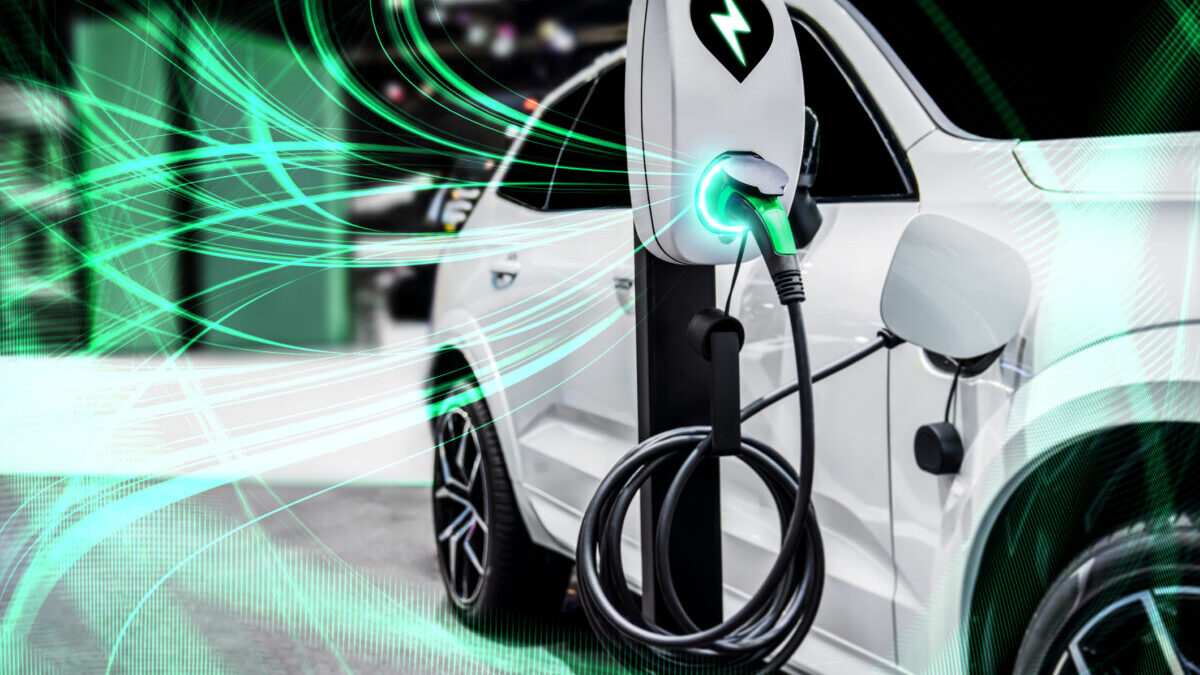South32 thinks electric vehicle batteries could account for 30% of manganese demand by 2030. Who’s along for the ride?

Pic: Blue Planet Studio/iStock via Getty Images
- South32 boss Graham Kerr says the US Inflation Reduction Act has improved the business case for developing its manganese rich Clark deposit in Arizona
- Kerr says manganese demand from batteries could make up 30% of the market in 2030
- A number of Australian companies are also looking to produce manganese for steel and battery markets
We’ve seen lithium, nickel, copper and more commodities froth more feverishly than a freshly poured Guinness in the past couple of years.
But the story about demand for metals from batteries goes beyond the most visible commodities that have drawn the interest of investors across the ASX.
Batteries, gigafactories, EVs and energy storage metal demands are eye-watering to say the least, and in most cases projections of future demand far outstrip what we can currently supply.
Take for instance, manganese. Around 90% of the global market for manganese comes from the steel industry, where it is used both in the refinement of iron ore and as an alloy which helps to harden and fortify the final steel product.
But it is finding an emerging market as a critical component of lithium ion batteries.
Manganese is one of the most common ores on Earth, something that has stirred investment in R&D to develop batteries with higher manganese contributions and lower levels of rare and expensive nickel and cobalt metal.
Even with current battery chemistries, Stockhead’s Reuben Adams estimates Tesla’s manganese requirements equate to around 14% of annual global manganese sulphate production, or 65% of the projected output of Element 25’s (ASX:E25) Butcherbird project in the Pilbara.
With that in mind there is a growing push for companies to develop new sources of high purity manganese sulphate, not least because around 90% of the market is concentrated in China.
Bearing in mind some grades of manganese sulphate go into fertilisers, according to data from the US Geological Survey US companies spent over US$28 million to November last year buying manganese sulphates out of China.
That number is around double the same period in 2021.
It has some of the world’s biggest mining houses taking notice, including $21 billion capped Aussie diversified miner South32 (ASX:S32).
30(%) for (20)30
South32 managing director Graham Kerr says manganese for batteries could rise from a tiny proportion of the end user demand to as much as 30% by 2030.
It has informed the investment case for the company’s Hermosa project in the United States.
The first cab off the rank at Hermosa, purchased in a US$1.3 billion cash buyout of TSX-listed Arizona Mining in 2018, will be the Taylor deposit.
A final investment decision on the development of that deposit is due by mid-2023 after a PFS last year suggested the mine would produce 111,000t of zinc, 138,000t of lead and 7.3Moz of silver annually over a 22-year mine life.
But the Clark deposit, also part of the Hermosa land package, is a different beast, containing a mixture of zinc, manganese and silver.
South32, a globally significant manganese producer through its 60% owned GEMCO operations in the Northern Territory and Wessels and Mamatwan projects in South Africa, announced a major technical breakthrough in its half-year results yesterday.
It says it has established the ability to produce high purity manganese sulphate suitable for batteries from its Clark deposit, where 9.08% of the 55Mt resource is manganese metal.
Should Clark be developed, it would make South32 the only miner producing manganese on US shores.
“We do believe that we’ve got to actually see manganese demand from batteries actually grow and that could possibly go from today where it’s probably somewhere around let’s say, 6%,” Kerr told media on a conference call yesterday.
“We believe by calendar year (20)30 it could actually get up to about 30%.
“So I think as that market continues to evolve — China today is probably the major producer of manganese into batteries (and) they’re probably going to be the dominant force in Southeast Asia and they export at the moment.
“But I think as you see legislative change occur in the US, which we’ll come back to, and similar kind of legislative change in Europe, both pushing EV vehicles, I think that will continue to actually grow the manganese demand into batteries.”
While investigations into whether South32 could produce manganese sulphate at its existing operations in Australia and South Africa are some way off, the introduction last year of the Biden Administration’s Inflation Reduction Act has shone a spotlight on Hermosa.
“The South African business and Australian business, we’ll look at the optionality around how we can support that. I think what positions Clark particularly well is it’s actually the only manganese project and there are no existing manganese operations today in the US,” Kerr said.
“The Inflation Reduction Act that came out last year was all about trying to push EVs in the US but also have secure and, where possible, domestic US supply chains.
“And I think that’s where Clark is uniquely positioned. And it’s not only about security of supply and domestic security needs, it’s also about the cost of logistics when you’re right in their own backyard.
“We will also look at what that means for the rest of our business as that market continues to develop. It’s more the US now where the demand from customers is incredibly strong.”
Inflation. Reduction. Act.
The key piece of legislation will provide tax credits for US battery makers who have a 40% share of their critical minerals coming from the United States or countries with which it has free trade agreements.
That rises every year until 2027, when the threshold will be 80%.
Those terms provide a strong platform for South32’s push into North America.
“There is no doubt that Inflation Reduction Act is having a positive impact on EVs, and a positive impact on demand for all the materials that are going to … go … into battery technology,” Kerr said.
“That Act has I think brought Clark quicker forward than what we probably would have planned.
“That’s why we’ve been accelerating work in that space. I think the team’s done a really good job.
“We shouldn’t lose sight of the fact that zinc that comes out of Taylor is also one of four critical minerals that are listed on that US critical minerals list and zinc is going to have an exponential increase in its demand with the growth of wind turbines.
“I think the other thing that will come out of Taylor will be silver which plays an important part in EVs, but also solar panels. So we’ve got two, if you like out of the four critical minerals.”
Manganese players emerging on the ASX
There are a number of manganese producers on the ASX currently, many like South32 looking to take a leading role producing high-purity manganese sulphate in the Western world.
Should batteries genuinely grab a 30% share of the manganese market, Australian companies working to provide high purity manganese sulphate produced outside of China will have a big role to play in the global battery industry.
OM HOLDINGS (ASX:OMH)
ASX-listed Malaysian based OM Holdings formerly ran the Bootu Creek manganese mine in Australia but is now a $600 million capped stock off the back of its processing operations in Malaysia.
OM sold 146,646t of ferrosilicon and 216,604t of manganese alloys for steelmakers in 2022 from its smelter in Sarawak’s Samalaju Industrial Park.
It has plans to ramp up total production output from 320-370,000t of manganese products this year to 610,000-640,000t in the future with a series of smelter developments.
However, it has yet to identify a definitive pathway for a move into the battery manganese sector.
“It’s probably going to be big in the future. In the short run, looking at what the Chinese are doing, it’s probably going to be oversupplied for the first couple of years, high purity manganese sulphate,” OM’s Adrian Low told Stockhead last year.
“I think for us it’s really in the manganese and silicon space that we just want to do everything. So on the silicone side, there’s ferrosilicone for steelmaking, there’s silicone for solar, that’s actually what we’re going to do.
“I know lot of companies have come out and claimed that they’re really efficient at producing HPMSM and saying high grade ores or other ores are good. We haven’t really studied that yet.
“I think we know traditional smelting really well, and the efficiencies and recoveries of that. HPMSM, not so much but I would absolutely say that’s something we will be looking at.”
BRYAH RESOURCES (ASX:BYH)
Bryah Resources has just about every commodity under the sun across its Bryah Basin projects, and includes an impressive portfolio of manganese assets.
They include the Horseshoe South mine, once operated by Chris Ellison’s mining services, iron ore and lithium giant Mineral Resources (ASX:MIN), Brumby Creek and Black Hill prospects.
All three projects are now part of a JV which OM Holdings has farmed into for a 51% stake.
Bryah announced a maiden mineral resource in March last year of 1.84Mt at 21% manganese, including 0.65Mt at 20% Mn on granted mining lease M52/86.
The explorer, which announced more high grade manganese samples in rock chips at the Bryah project this month, is targeting a resource in the order of 3-5Mt to provide the scale to restart production.
JUPITER MINES (ASX:JMS)
Jupiter Mines owns 49.9% of the Tshipi mine in South Africa, bordering South32’s Mamatwan operation.
The mine is a regular dividend payer and produced EBITDA of $47.5m and NPAT of $30.2m in the November quarter, having seen production and sales fall 12% and 16% respectively due to drill rig availability and South Africa’s Transnet rail strike to 748,000t and 781,000t.
Up to its latest report Jupiter said Tshipi was on track for 3.4Mt of sales in FY22-23, in line with historical norms, though it will make a record amount of high grade ore sales after suspending low grade tonnes due to poor prices for lower grade manganese.
It has yet to reveal concrete steps to enter the high purity manganese sulphate market, but has mentioned its growing use in batteries in presentations and with a more than 100 year mine life, is well placed to ride changes in the composition of the sector.
ELEMENT 25 (ASX:E25)
Owner of the operating Butcherbird mine in the Pilbara, Element 25 is one of the most advanced companies on the ASX when it comes to investigating the potential production of HPMSM.
Last month the miner announced an offtake and funding agreement with Euromerican auto giant Stellantis, owner of the Chrysler, Jeep, Peugeot and Fiat brands, which would see Stellantis part fund the development of E25’s HPMSM facility with a US$30m investment in two tranches.
As part of the deal E25 plans to supply up to 10,000tpa of HPMSM to Stellantis over five years, with the ability to increase volumes and the opportunity to extend the arrangement for its USA based facility beyond the initial five year term.
“Stellantis’ support for Element 25’s high purity battery-grade manganese sulphate project is a fantastic endorsement by one of the world’s largest automakers and supports our plans to become a globally significant long-term supplier of battery materials to meet growing global demand,” E25 MD Justin Brown said at the time.
“We are fully aligned with Stellantis’ decarbonisation and electrification goals, which represent some of the most ambitious in the industry and E25 have a pathway to reach agreed net zero carbon emission goals under this deal.”
“This is an important step in the delivery of our first production module which will combine Element 25’s innovative processing flowsheet and the high quality, ethically sourced manganese concentrate from our 100%-owned Butcherbird Project in Western Australia to deliver sustainable, ethically sourced battery grade manganese to the electric vehicle industry.”
A DFS is expected to be delivered this quarter, with E25 also looking into a potential second facility in Sarawak.
EURO MANGANESE (ASX:EMN)
Euro Manganese owns the Chvaletice manganese project and is squarely focused on the emerging manganese battery market.
It plans to extract manganese rich tailings from a decommissioned mine in the Czech Republic and convert them into high purity manganese sulphate material for lithium ion batteries.
Also listed in Toronto and Frankfurt, EMN announced its first offtake agreement in January in the form of a non-binding deal with Verkor, a low carbon battery manufacturer based in Grenoble in France, whose shareholders include Renault, Schneider Electric, Capgemini and Sibanye-Stillwater.
First production is expected at Chvaletice by 2027, with EMN claiming its CO2 footprint is forecast to be around a third of the Chinese HPMSM industry.
Firebird Metals (ASX:FRB)
Firebird Metals boasts the Oakover project in WA, where it has started a scoping study into the production of HPMSM after positive testwork last year.
Located 85km east of Newman, the explorer last month announced it had successfully produced a 99.8% purity manganese sulphate monohydrate crystal from its Oakover ore, meeting battery grade specification and containing upwards of 32% manganese.
“This is an outstanding result and places Firebird and Oakover in a very strong position moving forward. To produce greater than 99.8% manganese sulphate purity from our first test work program is a testament to the hard work and dedication of our team and advisors. It is highly encouraging that this result meets the requirements for battery grade specifications and highlights the high-quality nature of our flagship Oakover Project,” FRB MD Peter Allen, sometimes referred to as Mr Manganese for his decades of experience in the sector, said.
“Importantly, we are developing Oakover at a time where demand for manganese within the lithium-ion battery sector continues to grow rapidly, as electric vehicle and battery cathode manufacturers have stated their desire to increase the amount of manganese within lithium-ion batteries, due to the cost benefits obtained whilst maintaining energy density.
“We have taken a major step as a manganese developer and we will now focus our attention to rapidly progressing and completing our high-purity manganese sulphate scoping study, which we announced in October.”
Black Canyon (ASX:BCA) and Carawine Resources (ASX:CWX)
Black Canyon plans to deliver a HPMSM scoping study later this year for its suite of manganese assets in the Pilbara.
They include the 171Mt at 10.3% Mn Flanagan Bore deposit, where BCA has earned in to a 75% stake in a JV with the project’s original owner Carawine Resources.
Metallurgical test work has demonstrated Flanagan Bore can deliver concentrate grades in excess of 30% Mn, while initial sighter testwork has confirmed the leachability of manganese oxide ores from which Black Canyon says it can crystallise a high grade manganese sulphate product.
“By demonstrating the ability to produce manganese sulphate with a 32.3% Mn content, which is highly comparable to the typical 32.2% Mn content of HPMSM, represents a significant achievement for this initial phase of testwork,” BCA executive director Brendan Cummins said in December.
“Black Canyon is rapidly developing a business case for both manganese concentrate that can be sold in the steel industry and manganese sulphate suitable for the growing electric vehicle battery market that is underpinned by a significant Mineral Resource with the potential for a multi-decade mining operation at Flanagan Bore.”
Related Topics
UNLOCK INSIGHTS
Discover the untold stories of emerging ASX stocks.
Daily news and expert analysis, it's free to subscribe.
By proceeding, you confirm you understand that we handle personal information in accordance with our Privacy Policy.








